Pop Stuff: Five O’Clock Somewhere
‘Let me conjure a cocktail tour of Manhattan, one that those wordsmiths who were partial to the bottle might like to take’
On a recent Sunday night, I walked down a short flight of steps on Grove Street in Manhattan’s West Village and through a door marked with a compass, as if to indicate I was in the right place. Inside, a hostess with a bright smile and kind eyes (that urban rarity) asked me a wait just a couple minutes till a seat cleared. I remembered the drill – just as many people as there were seats, my kind of bar. A few minutes later, I was seated on a tall chair in the center of a long wood counter, so cozy I could wrap my arms around it, looking up at a plump angel with the tiniest devil’s horns peeking out from his sleek black mop. He was wearing a blue velveteen robe, his eyes cast down towards the almost cloudless sky, towards ringleted cherubs, towards the bar from which he was likely inhaling the angel’s share. Angel’s Share (the bar’s namesake) refers to the alcohol lost to evaporation when a spirit is poured into oak barrels, an undefinable sliver – just enough to get a cherub high.
If this image isn’t familiar, it’s the mural that was painted for Tony Yoshida and which, for three decades, presided over the restaurateur’s beloved East Village craft cocktail bar. The discrete second-floor bar on Stuyvesant Street opened in 1993 and shuttered nearly thirty years later only to find this West Village reincarnation under the auspices of Tony’s daughter Erina, because only family could carefully carry the legacy of no standing, no reservations, no parties greater than four and drinks crafted with the utmost care. I scanned the day’s menu for gin cocktails and, after some deliberation with a patient mixologist, selected the Harvest; Roku gin mixed with wine cordial, yogurt and honey, all garnished with a lavender sprig and served up perfectly chilled. I sipped this precursor to autumn in a delicate stemmed coupe glass. I settled in and I cracked the spine of a book because, despite having room for sixty-five – every spot filled, here, I could feel like there was little between me and the page, except for a drink that blurred the outside and sharpened the words.

It was when I began frequenting Angel’s Share in its first incarnation that I realized I loved a cocktail. I have never been much of a drinker, and unlikely as it might seem reading this, I’m still not much of one. But the truth is my early drinking was always for other people. Sometime in my teens my best friend and I flung open her father’s bar and went at the vodka, just so we could know what we were in for when we had to perform shots for other people. During my first late-night New Year’s Eve party, even this preparation was little protection; I spent the better part of the night expunging something spiked. In college I knocked back thick, dark Jägermeister to signal my fearlessness and called my mother in India, complaining of a hangover worse than home sickness. In my early years in New York, I drank to make things palatable from bad techno to long work hours. Later in my twenties, I ordered middling red wine with dinner as a badge of elegance. At one point I drank Remy solely because father had sipped on it while smoking a pipe and later I quit drinking altogether because it felt like a great way to get an alcoholic boyfriend on the wagon. This dry spell ended up lasting a decade in which I didn’t miss alcohol at all, because I imagined it was never for me to begin with.
I was well into my thirties before I embraced the joy of sitting at a bar and enjoying a spirit, before I understood that spirits were so named because while emotions might unlock a soul, libations could at least dislodge it. A cocktail became a true indulgence when it was no longer front, cover-up, game, or plea for inclusion and when I found the form in which it offered me maximum pleasure; at a deep bar, pen in hand and book in the span of my palm, or whilst sipping a bitter aperitif under an eave with a friend and the tinkle of live music nearby. It was then I began to recognize the taste of juniper berries lending pine and citrus to gin, the flinty minerality of an excellent dry wine and that a Negroni was worthy but a White Negroni was enchanting. My preference was for a cocktail lounge, with a little night music, where the attention to craft extended from the lip of the glass and the shape of the ice to the precise shade of grey that turned a Dirty Martini the color of river water. Without glamorizing addiction, I realized alcohol’s lure need not look like Charles Bukowski knocking one back in a cloud of smoke in a dive bar at midday, Cheever downing his eleventh Manhattan or Tennessee Williams in the shadow of Broadway, hip flask at the ready. If whiskey was Hunter Thompson’s best muse, one he described as the ‘quiet enveloping darkness at the bottom of a bottle of Jim Bean, after a job done any way at all’, Jane Austen was more partial to the kind of slow buzz I could appreciate, quipping of the douceurs of an aging that allowed her to be ‘chaperon’ because, ‘I am put on the sofa near the fire and can drink as much as I like’.
Put me on that metaphorical sofa now too and let me conjure a cocktail tour of Manhattan, one that those wordsmiths who were partial to the bottle, women I read keenly, their pages shaping and beguiling me, might have taken.
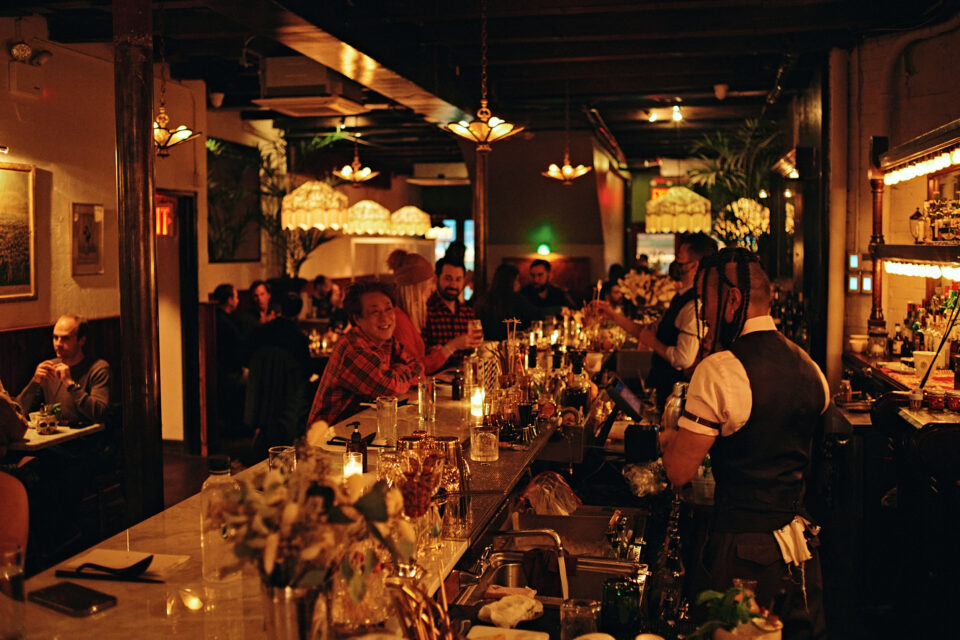
I imagine Austen time traveling forward and across the Atlantic to be drinking companion to Zelda Fitzgerald, to whom her husband F. Scott Fitzgerald owed much of his success and many of his ideas. Surely Austen would encourage her drinking partner’s considerable talents as a writer as she fortified her with spirits? Jane and Zelda might begin a Tuesday night cocktail tour of the Upper East Side at NR. An intimate and unassuming ramen joint with one of the most gorgeous bars in the neighborhood, and possibly in the entire city – gilt-edged with a rocking horse at its center, NR conveys an atmosphere that can be best described as jazz-age exuberance meets eastern charm. It is that rare spot that is transportive even without imbibing, effervescing with the care and attention paid to a tasseled lamp shade, a picture frame-worthy flight of deviled eggs, or the origami swan paperclipped to a cocktail in place of a ubiquitous umbrella. Angel Share alum and NR proprietor Shigefumi ‘Shige’ Kabashima owns and runs precursor ROKC in West Harlem, which matches NR for having created something both exquisite and original, the kind of place that imbues a city block with charm. He has also developed the small but impeccable list of cocktails in midtown’s modern Italian bar, Katherine – worth visiting for that reason alone.
After noodles and Asian Mules laced with cardamom and lime, Jane and Zelda might venture over to Bemelman’s, the upscale piano bar in the Carlyle Hotel. This tell-all spot with its gold-leaf ceiling, rose-inflected lighting, playful murals that speak the city’s history and maroon banquettes, glows as its musicians sparkle. In its eighth decade, it’s younger than Zelda would be, but still old enough to have seen a few things and deliver a signature Manhattan in which the notes of Santa Teresa Rum mingle with orange and Angostura in something close to symphonic. Our literary pair might follow Bemelman’s with nightcaps at Jeremy’s – a relative newcomer to the east eighties, unassuming only on the outside revealing a sleek room with velvet cubbies and a marbled bar, or at UES a stone’s throw away where an ice-cream shop in the front hides a speakeasy in the back; ask the ice cream scooper for the storage room and experience a different world.
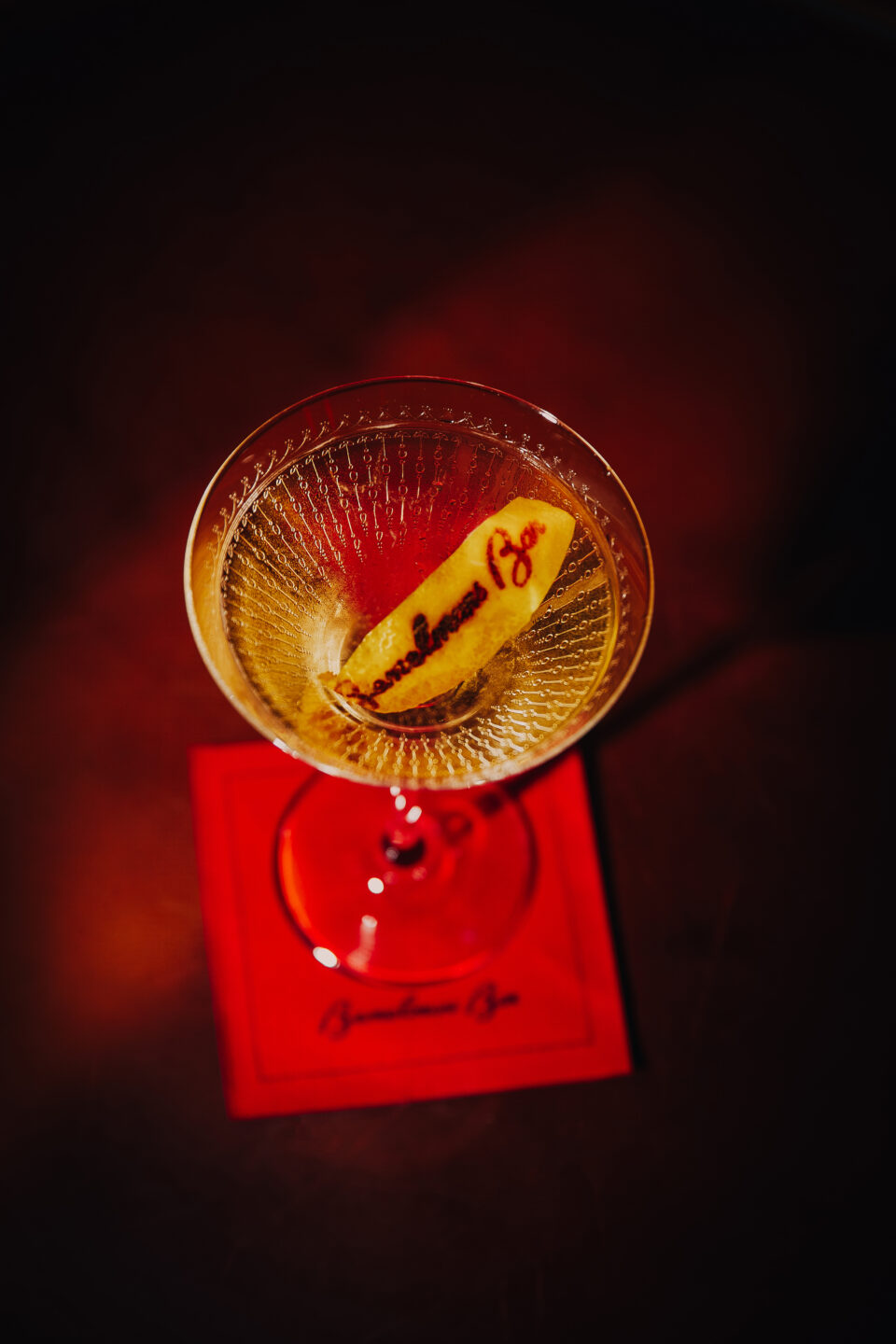
My personal uptown favorite, when I’m not craving a side of ramen, has as much to do with vibe as libations, and the vibe I hanker for is distinctly tropical and seductive, a callback to my native Mumbai. Sugar Monk in Harlem is a jewel box of a cocktail bar; a pocket-sized spot with green velvet chairs and banana leaves on the walls. Just blocks from the Apollo Theater, the bar which opened in 2019 from partners Simon Jutras and Ektoras Binikos, seems torn from a page of the Harlem Renaissance and feels like it has always belonged. Here is where I imagine poet, writer, activist, Maya Angelou, deep in conversation with her real-life friend Ada ‘Bricktop’ Smith, a self-described saloon owner known for her flaming red hair, big voice and vaudevillian dance moves. Angelou worked at Bricktop’s club for a time as a singer and later wrote about her in the third volume of her autobiography, Singin’ and Swingin’ and getting Merry Like Christmas. What would these women say to each other over the modern alchemy that is a Sugar Monk drink fashioned from Binikos’ DIY ethos and meticulous work with the forager Tama Matsuoko Wong on amari, bitters, tinctures and liqueurs that span every note from bay leaf to spicy rhubarb? I can only imagine Angelou who wrote from dawn every morning to past midday with, ‘a Bible, a thesaurus, a dictionary and a bottle of sherry’ for company, would raise a glass here with reverence. If warming sherry is not your bag, try Sugar Monk’s Ma Mandelbaum. Named for crime queen and society hostess Fredericka Mandelbaum, this cocktail swirls citruses and lavender in gin, calling forth the open sky.
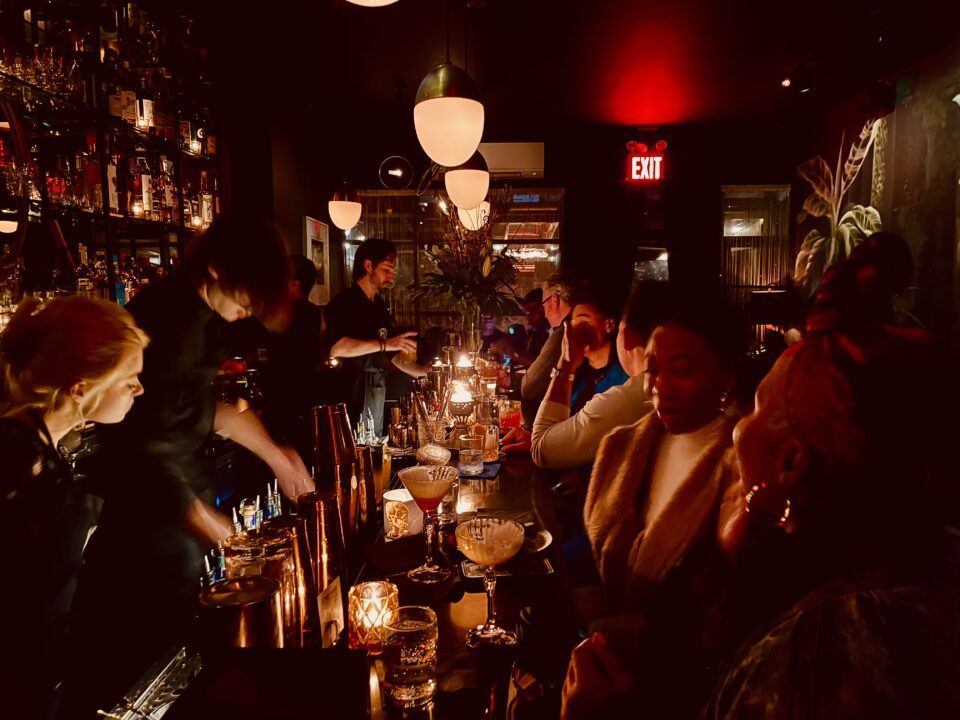
Closer to home for me than Sugar Monk, a few blocks from my apartment in Lenox Hill and another tropic-themed escape, is Melody’s Piano Bar from the Martignetti brothers, fixtures in New York’s restaurant scene. Melody’s opened last year amidst something of a renaissance of live jazz and piano bar venues that are distinct from some of their precursors because of the careful attention paid to craft cocktails. The sixty-seat spot at Melody’s is replete with black lacquered bar, palm leaf wallpaper, slatted wood dividers between nooks and a checkered floor, all of which somehow deliver up In the Mood For Love feels à la Wong Kar Wai. It is style that stands up to the substance of the talented nightly performers and the delightful cocktails. I have found myself ‘returning’ to Melody’s after dinner with a rowdy group for a late-night jazzathon, with a girlfriend for a nightcap, and by myself for the desert in a glass that is the Grace Kelly; mezcal, chocolate bitters, raspberry, cava rose and rosemary – heaven.
Other highlights of the live music revival are as disparate as they come and replete with cocktail-infused decadence; Tomi Jazz and The Nines are my go-tos. Tomi Jazz in midtown (the original was part of the Little Tokyo zone of the East Village that included Angel’s Share) is a far cry from a space that once catered to Japanese businessmen. Ken Mukohata’s underground spot, tucked away amidst the nondescript office blocks of the east fifties, opens into a basement that is as charming as any you will ever see. Here, whilst poring over a read and listening to an enchanting flutist and a glorious sax, I’ve enjoyed fried oysters and sipped on cool sake in a wooden box. Behind the tiny L-shaped bar, bedecked with dusty liquors and antique lamps, sits a soft-serve machine. As appealing as it seems, I recommend skipping the cone and ordering instead the Honey Toast with ice cream; fat slices of toasted Japanese milk bread drenched in vanilla. For a swankier evening The Nines, a red-velveted supper club in Jon Neidich’s former ACME space, is just the ticket and a signal that the spot has grown up. Along with some superb cocktails on offer is one of New York’s most delicious burgers, garnished with black garlic and onions – a great accompaniment to a classic Vieux Carré.
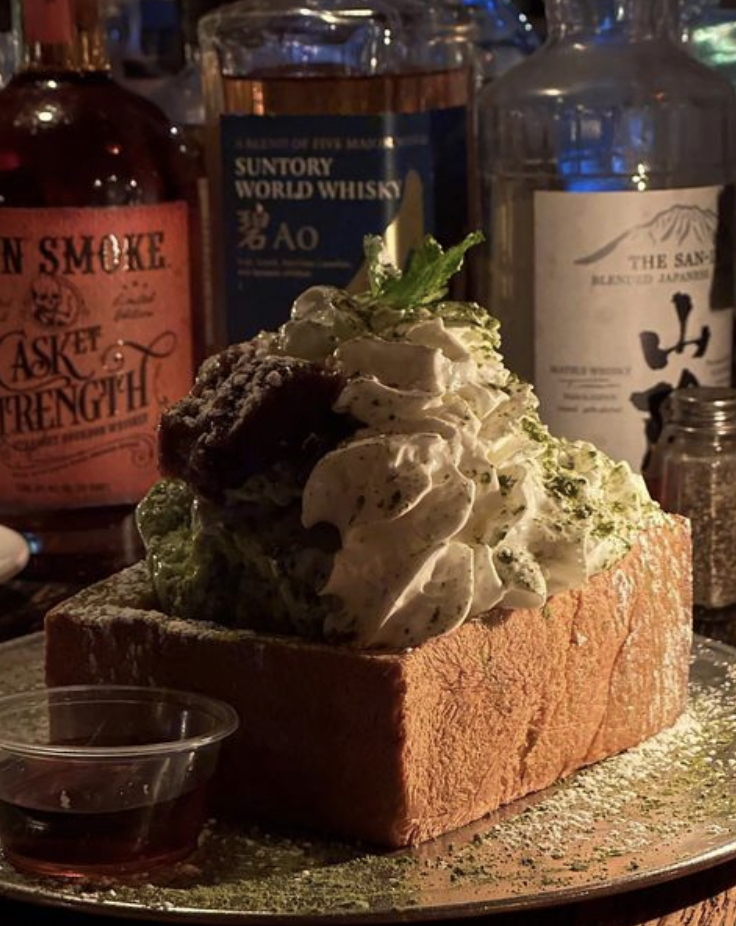
Pebble Bar deserves a mention here too, not least because it is the rare place that makes me feel like old New York can be new again. While not boasting live music, its proximity to Time Square means the sleek lounge welcomes a pre- and post-theater crowd who are all about live performance and just as animated. The third-floor cocktail bar cum dining room hidden betwixt draped windows in a townhouse at Rockefeller Center sits in a location that was once home to Hurley’s, the century old Irish saloon. Perhaps that’s why, at barely a year old, it already feels like a New York institution and is proof that cocktails in midtown can be a destination affair. Hurley’s regulars included Kerouac, Carson and Letterman. But to my mind, Dorothy Parker might have nestled into the corner table at Pebble Bar with her pad and rolled her eyes at them all as she scribbled theater reviews for Vanity Fair, a magazine she claimed had no opinions while she had plenty. Parker, martini in hand, fashioned from her namesake gin, would do well to try one of the bar’s flightier cocktails. The Last Waltz – Bombay Sapphire draped with Chartreuse, orange, lime and brine – equal parts sweet and bitter – seems especially fitting for the grande dame of bon mots, who founded the Algonquin roundtable just blocks away.

Parker, who came of drinking age not long before prohibition, once said, ‘I like to have a martini, two at the very most, after three I’m under the table, after four I’m under my host’. This didn’t stop her from drinking bootleg liquor whilst writing through the night and often sleeping it off most of the day. She went on to write all manner of things; opinion pieces for New Yorker, poetry collections and eventually scripts. I imagine her making her way from Pebble Bar to pen poems at Jac’s on Bond in Noho and then across the river to Brooklyn, to Bar Blondeau for a Sunset Fizz and on to Hotel Delmano and Maison Premiere. Between a Delmano Smoke and Flowers (scotch with a heady dash of St Germain, sherry and vermouth) and a Maison Premiere Sazerac (made aromatic with Creole bitters), she would have critiqued her beloved Manhattan at a remove, and well into dawn, before Hollywood came calling for her.
Indeed, two of the best rooms from which to offer a Parker-esque critique of Manhattan’s arrivistes, hipster-elites and stealth-wealth aspirants are the city’s most undeniably gorgeous cocktail lounges. The Swan Room, part of the luxurious boutique hotel Nine Orchard, arrived in 2022 in the century-old former Jarmulowsky Bank building on Canal and Orchard, a stunning but crumbling Beaux-Arts structure that has thankfully been revitalized with immaculate attention to old details. The Swan Room lobby bar is the jewel in the crown of the structure, proffering a majestically high ornamental ceiling which is the only thing that could pull your eyes from a sumptuous bar that is all marbled swirls and old-world sophistication. This is a room that, despite all those who want to hate on the culture-stripping of the lower east side, would have made Gertrude Stein blush with pleasure. I was a virgin to White Negronis before my first here; Suze, Lillet Blanc, gin and lemon peel with a dash of something proprietary which made it perfectly herbaceous, daintily floral and impossible to replicate. Undeniably the kind of drink that deserves to be garnished with a delicate leaf and offered up on a heavy-bottomed tray by a server in a white jacket and bow tie.
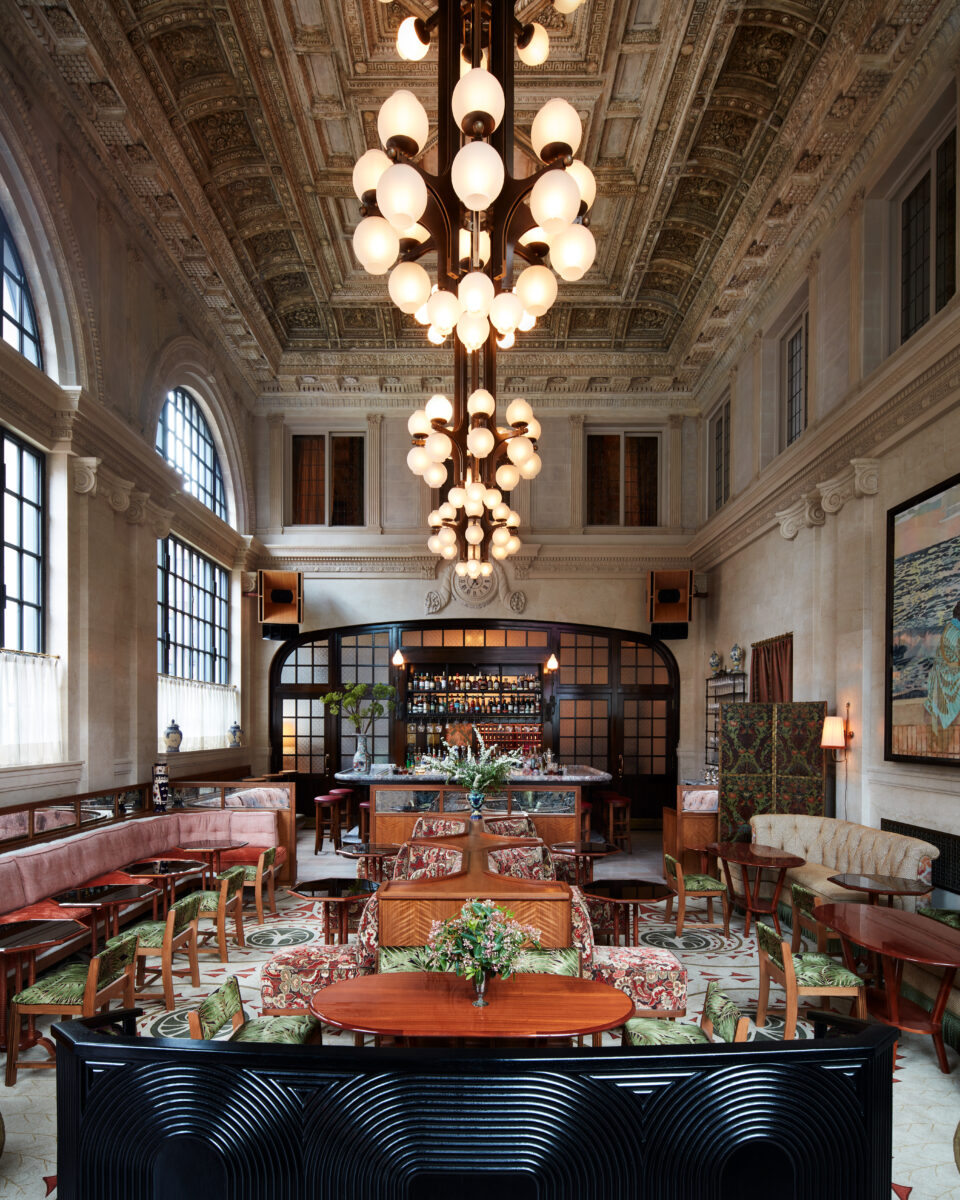
The Swan Room at Nine Orchard. Photo: Stephen Kent Johnson
Overstory in the Financial district swaps the Swan Room’s opulence for the abundance of riches that comes with unencumbered sightlines. Located on the sixty-fourth floor of 70 Pine Street with a three-sixty-degree wraparound terrace, Overstory is a spot from which the city unfurls languorously in every direction. In spite of this, the rose-hued bar is magnetic and, with its handful of seats, manages to feel cozy and tranquil whilst the outdoor tables are a Manhattan oasis. Overstory comes from the Crown Shy and SAGA teams, restaurants that have imbued their fine dining ethos with a warm hospitality and it shows even in this perch elevated atop the city, thanks in large part to beverage director Harrison Ginsberg’s penchant for keeping things grounded. The deceptively straightforward cocktails and their no-buzz counterparts are the liquid equivalent of meticulous farm-to-table cooking where each ingredient shines. The In The Clouds – whiskey, earl grey, vanilla, champagne and clarified milk – will carry you to the other side of sublime.

Still, there are the misfits who would have shunned these vaunted rooms as hotbeds of clicking heels and heavy wristwatches. Those writers who wrote the literal hell out of their women and men. Jean Rhys, the writer that had the greatest impact on me as a teen via her brief and visceral re-imagining of Jane Eyre’s ‘mad woman in the attic’ – Rochester’s Caribbean-born wife, would, if she moved across the Atlantic, have settled on a part of Lower East Side that retained a trace of grime as her haunt of choice. England was Rhys’ adoptive country and one that never really embraced a woman who grew up in Dominica, part Welsh, part Scots-Creole and, as the Brits would insinuate, all mongrel. She would surely find solace in a part of the city once known largely for its population of immigrants and, after doing the rounds of its back door cocktail lounges – Please Don’t Tell, The Back Room, Death and Company – she might settle on one that has become at once mythic and discrete.
Attaboy, a bar in the small space that more than ten years ago was home to Milk and Honey, forerunner of the craft cocktail movement, is a menu-less space where you speak your mood and the bartender artfully mixes it into a tumbler. Rhys who declared, ‘I have decided on a place to eat in at midday, a place to eat in at night, a place to have my drink in after dinner. I have arranged my little life,’ could have felt at home here; undoubtedly the warm, dimly lit bar would fit the bill. For a drinking companion, my money is on Marguerite Duras joining Rhys in Attaboy’s nether reaches where a clutch of forest green leather booths disappears into the back. Duras, who called alcoholism ‘scandalous in a woman…a slur on the divine our nature’, embraced it, nonetheless. Like Rhys, she was a post-colonial writer who made her way back to her own French imperial motherland only to experience an unforeseen dislodging of her birthplace, French Indochina, now Vietnam. Sipping bourbon, vermouth and woodsy amaro over single hunks of ice at Attaboy, could there be a better duo to dissect the politics of location and the even more political displacement of women who make unconventional decisions?

Amor Y Amargo, a few blocks up from Attaboy, is another place I return to in the East Village, largely because of its pioneering focus on bitters. In its distinctly masculine and enveloping recesses, I can see a different pair of misfits – Patricia Highsmith and Shirley Jackson, engaged in the kind of straight-talking banter that is as clean as their sentences. Both women liked to drown their ideas and their sorrows in tipple, perhaps because it aided them in masking life’s cruel yet mundane eventualities behind the crime and horror stories they trafficked in. These don’t-give-a-damn women did meet at least once in real life; Highsmith accompanied a friend to coffee at the apartment Jackson shared with her husband, but they would have done better to raise glasses at Amor Y Amargo’s eight-seater bar. Barman’s Sother Teague’s application of bitters to bring out hidden depths in any drink is something that sets his creations apart, making his spot a necessary stop on any cocktail lovers map. Over bevvies laced with aromatic, floral or musky bitters Highsmith could stack her charismatic men against Jackson’s brooding women – have Tessie Hutchinson give Tom Ripley a run for his money. Both writers’ protagonists were tinged by a self-hatred rooted, no doubt, in fractious relationships the authors had with their mothers and their partners – women who left her for men in Highsmith’s case and a husband whose infidelities Jackson put up with through gritted teeth. A watering hole attune to complexity and ahead of the curve seems only fitting for fire and brimstone women who wrote their way into a celebrity that would balloon posthumously, so defiantly were they ahead of their times.

And what of their more overtly delicate sisters-in-arms – the poetesses? Where would Anne Sexton clink a glass with her contemporary, Sylvia Plath? More than a birthplace, a poetry workshop, and later a psychiatric hospital, these two shared an uncanny ability to make their poems sing, groan, beg, urge and haunt. Perhaps Elizabeth Bishop, a generation older and likely capable of drinking them both under the table, would chaperone them through the speakeasys of Nomad and Chelsea, beginning with Raines Law Room and moving on to Patent Pending, one tucked in a basement, the other behind a coffee shop, both delectable. The neighborhood has become something of a cocktail bar destination, other highlights include Thyme and Apotheke, but my guess is these Massachusetts-bred women would do well to trade industrial chic for the West Village’s leafy streets, cheering their still-water exteriors and breaking their depressive spells, if only for a single sun-kissed evening.
Dante, a name that is over a century and a few facelifts old began with the original Caffe Dante on Macdougal street in Greenwich Village and has since – in 2020, opened a West Village location that, all minty window frames decked with fresh flowers, is one of the prettiest bars in a neighborhood sprawling with them and a haven of aperitifs. Its latest iteration might include some of the finest cocktails in its hundred-and-four-year-old history. You could do worse than beginning an evening with a Dante’s Mezcalito, a hibiscus infused mezcal affair mingled with Contratto aperitif, pale and dark vermouths and a cherry liqueur.
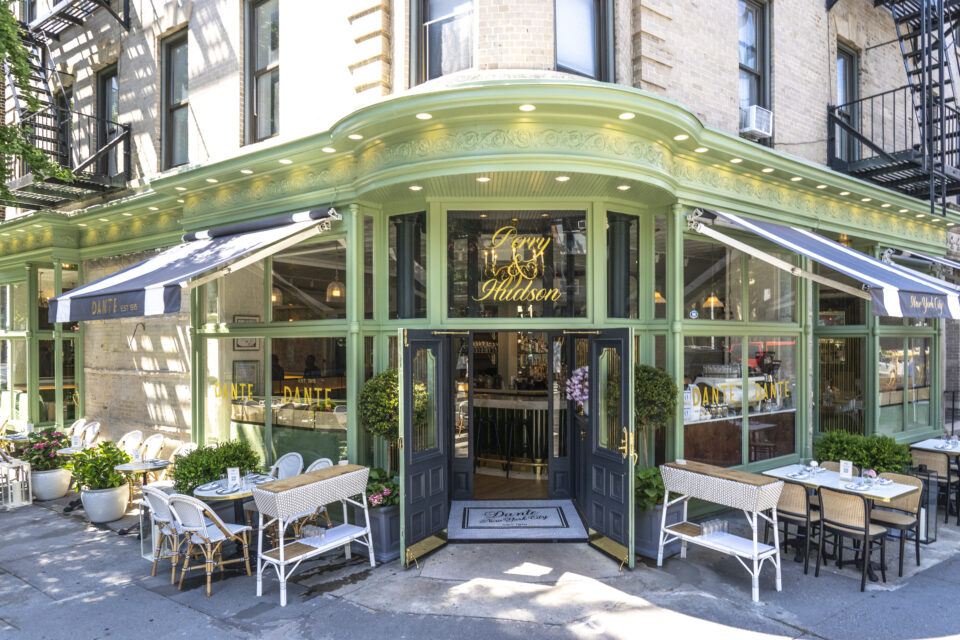
Tipsy with Mezcal,our trio might stroll a few blocks from Dante to Katana Kitten for nibbles, tunes and more fortification. Masahiro Urushido’s spot smacks of Osaka underground and riffs on Japanese influences like Fumio Nanri on his best night. Open since 2018, Katana has since landed on a number of best-of lists and deserves every last drop of the hype. Here, I envision Bishop raising a Toki Highball to Plath’s El Camino and Sexton’s Meguroni. The dry vermouth in the Camino would blissfully sate Plath’s penchant for sherry while retaining a feel of summer from the iichiko shochu, green tea and cucumber. The Meguroni (I seem to search for a variation on the classic everywhere I go) is deeper, blending shochu with Caffo Red Bitter, but still easy, drawing in the yuzu, grapefruit and mint notes of kinome leaves. Both drinks make excellent use of umeshu, a Japanese liqueur made from steeping ume for a wonderful stone-fruit depth that is as round and full on the palate as the one-bite plums it is named for. What Katana Kitten does just as artfully is blend the delicacy that the Japanese are known for with a punch, not just of its liquors but of bold music, fat decapitated shrimp appetizers, a banging teriyaki burger on a fluffy potato bun and the vibrant red shiso leaves grown in Urushido’s own Brooklyn garden. Katana Kitten has nailed the contradiction implied in its name – a reference to the samurai’s sword, paired with a feline softness. I can’t think of anything more fitting for three warrior poets who wielded words with the cat-like agility of fencers.
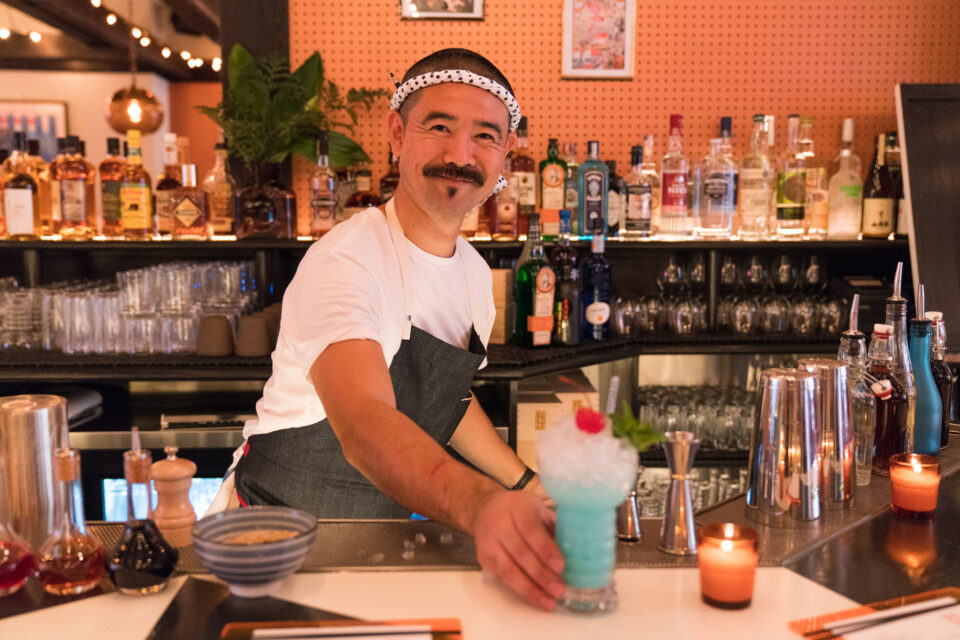
And for a nightcap, well they could end up right where we started, just steps from Katana at Angel’s Share, under the mural. After all, isn’t it in that liminal space, where spirit becomes vapour, that the word truly begins to dance on the page?
Soleil Nathwani is a New York-based Culture Writer and Film Critic. A former Film Executive and Hedge Fund COO, Soleil hails from London and Mumbai. Twitter: @soleilnathwani




